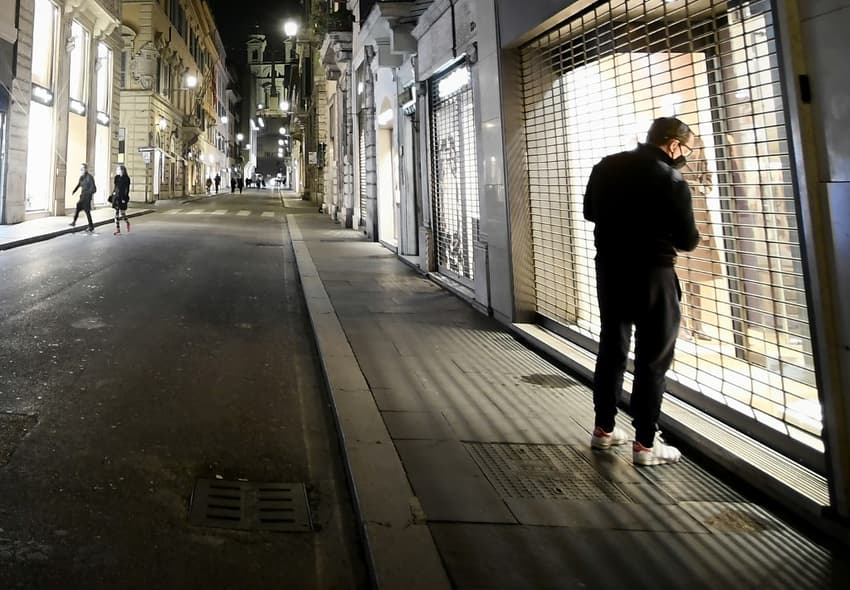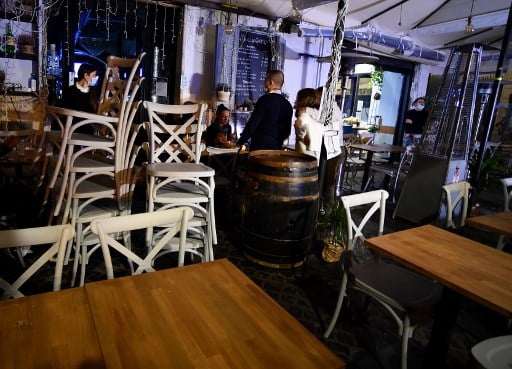Curfew or lockdown: What will be in Italy's latest emergency decree?

The Italian government is on Monday drafting the latest in a series of emergency decrees aimed at stemming the spread of Covid-19. Here's what we know about it so far.
Italy's latest set of coronavirus rules is set to be announced on Monday, making this the fourth emergency decree announced since October 13th.
AROUND EUROPE: The relentless resurgence of coronavirus causes unease and despair
New measures are to include a "late evening" curfew and restrictions on travel between regions deemed "at risk", accordng to Prime Minister Giuseppe Conte.
While many in Italy were expecting some form of lockdown in the coming days, with new cases now over 30,000 a day, the government has instead opted for a nationwide evening curfew.
While the continually rising case numbers have forced the government to bring in further restrictions sooner than originally planned, it remains against implementing nationwide measures and instead opted to tighten restrictions in areas with the highest transmisson rates.
Prime Minister Giuseppe Conte outlined the latest planned restrictions in a speech to the lower house of the Italian parliament on Monday afternoon.
"In light of last Friday's report (from the Higher Health Insitiute) and of the particularly critical situation in some regions, we are forced to intervene, with a view to prudence, to mitigate the contagion rate with a strategy that must correspond to the different situations of the regions," he said.
Local or regional lockdowns?
Conte confirmed that the government is not planning to bring in sweeping nationwide measures, but "there will be targeted interventions according to the risks in the various regions".
He said this would include a "ban on travel to high-risk regions, national travel limit in the evening, more distance learning, and public transport with a capacity limited to 50 percent ".
Regional governors had been pressing for rules to be applied at national level, but the national government instead wants to limit restrictions to "red zones”, based on the local infection rate (depending on the Rt number, or transmission index), according to Italian financial daily Il Sole 24 Ore.
Evening curfew throughout Italy
Conte confirmed that a nationwide evening curfew would be included in the new decree.
This would mean the closure of all shops, except for pharmacies and food retailers.
While Italy’s worst-hit areas currently have their own curfews in place - including in the cities of Milan, Rome, and Naples - this rule could be extended and standardized nationwide under the new decree as a form of compromise between the national and regional governments.
It is not yet known what time the curfew will begin. Regional heads are reportedly pushing for a 9pm curfew while the CTS recommended 6pm.
Conte did not specify the time, only saying it would be in the "late evening".
 Customers at bars in Rome need to drink up by 6pm under the current local curfew. Photo: AFP
Further business closures
Conte said the new decree would close museums, galleries, betting shops and arcades - in addition to the closures of gyms, pools, cinemas and theatres under the last set of rules.
"We'll close shopping centres on public holidays, with the exception of food stores, drugstores and pharmacies and newsstands inside the centres," he said, adding that these were "specific measures that help to strengthen the containment and mitigation of the contagion."
This is likely to be the most controversial measure following widespread protests last week over current restrictions on restaurant opening hours, but ministers insist financial support will be available for affected businesses.
'We have to follow the scientific advice. It is inevitable in this second wave that further measures are taken, accompanied by economic support,” said Roberto Gualtieri, Minister of Economy and Finance. “This requires painful intermediate measures."
"The more effective they are, the better we will be able to avoid a new lockdown. The government will give all the necessary support to the extent that it is needed. We have the resources to do that," he told Ansa.
Remote work and study
Public administration workers may be required to work from home where possible under new rules.
While high schools are currently asked to teach classes online, this measure will now be extended to middle schools, Conte confirmed.
The national government is not currently discussing school closures, though some regions including Puglia have chosen to require all schools to teach remotely.
Find all The Local's latest coronavirus updates here.
Customers at bars in Rome need to drink up by 6pm under the current local curfew. Photo: AFP
Further business closures
Conte said the new decree would close museums, galleries, betting shops and arcades - in addition to the closures of gyms, pools, cinemas and theatres under the last set of rules.
"We'll close shopping centres on public holidays, with the exception of food stores, drugstores and pharmacies and newsstands inside the centres," he said, adding that these were "specific measures that help to strengthen the containment and mitigation of the contagion."
This is likely to be the most controversial measure following widespread protests last week over current restrictions on restaurant opening hours, but ministers insist financial support will be available for affected businesses.
'We have to follow the scientific advice. It is inevitable in this second wave that further measures are taken, accompanied by economic support,” said Roberto Gualtieri, Minister of Economy and Finance. “This requires painful intermediate measures."
"The more effective they are, the better we will be able to avoid a new lockdown. The government will give all the necessary support to the extent that it is needed. We have the resources to do that," he told Ansa.
Remote work and study
Public administration workers may be required to work from home where possible under new rules.
While high schools are currently asked to teach classes online, this measure will now be extended to middle schools, Conte confirmed.
The national government is not currently discussing school closures, though some regions including Puglia have chosen to require all schools to teach remotely.
Find all The Local's latest coronavirus updates here.
Comments
See Also
Italy's latest set of coronavirus rules is set to be announced on Monday, making this the fourth emergency decree announced since October 13th.
AROUND EUROPE: The relentless resurgence of coronavirus causes unease and despair
New measures are to include a "late evening" curfew and restrictions on travel between regions deemed "at risk", accordng to Prime Minister Giuseppe Conte.
While many in Italy were expecting some form of lockdown in the coming days, with new cases now over 30,000 a day, the government has instead opted for a nationwide evening curfew.
Prime Minister Giuseppe Conte outlined the latest planned restrictions in a speech to the lower house of the Italian parliament on Monday afternoon.
"In light of last Friday's report (from the Higher Health Insitiute) and of the particularly critical situation in some regions, we are forced to intervene, with a view to prudence, to mitigate the contagion rate with a strategy that must correspond to the different situations of the regions," he said.

Join the conversation in our comments section below. Share your own views and experience and if you have a question or suggestion for our journalists then email us at [email protected].
Please keep comments civil, constructive and on topic – and make sure to read our terms of use before getting involved.
Please log in here to leave a comment.